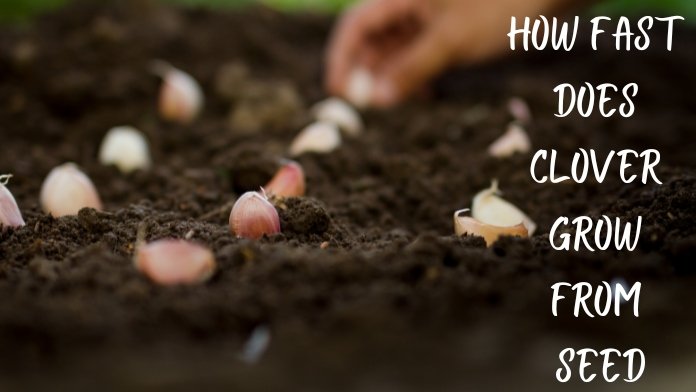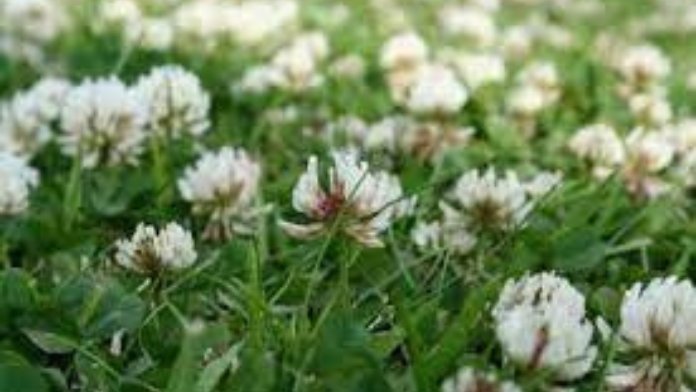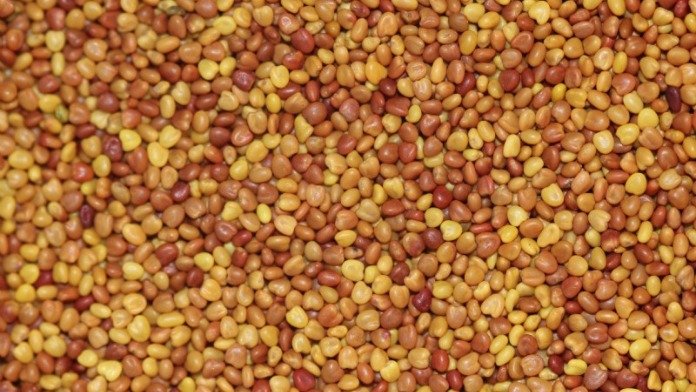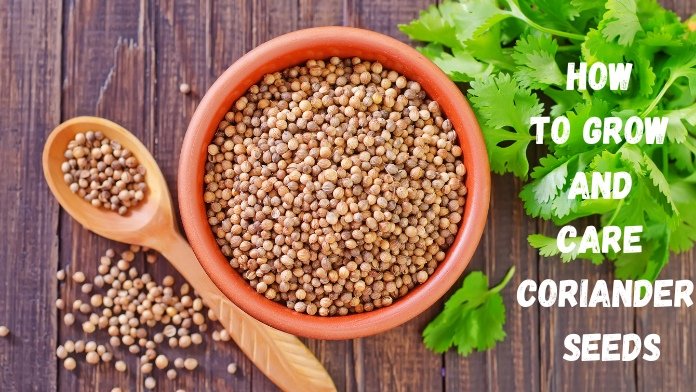
Have you ever wondered how fast clover grows from seed? Well, look no further because we have the answer for you! A small, delicate plant with clusters of three leaves, clover has a relatively fast growth rate compared to other plants. On average, clover takes 4-6 weeks to fully establish and turn into a bright, vibrant green carpet.
Clover, a popular plant known for its nitrogen-fixing properties and ability to improve soil health, requires certain conditions for optimal growth.
Several factors affect clover growth, including soil type, temperature and climate, irrigation, sunlight, clover type, seed quality, fertilization, weed control, and crop pest and disease management. Understanding these factors and applying proper practices can ensure successful clover growth in your garden or field.
Clover Basics
Clover needs water, sun and lime (mostly in soil) for good germination. Clover obtains its phosphate and potash from the soil and its nitrogen from the air through bacteria in its roots. Lime is needed to keep the soil pH neutral (6.0 to 7.0 for best performance).
In acidic forest soils (especially areas with acid rain), clover will not grow without lime. Lime will also release phosphate and potash from dark forest soils, reducing the need for fertilizer.
To ensure successful planting with clover seed, perform a soil test to check the pH of your soil. This will allow you to use the right amount of lime for good germination and establishment.
How to plant Clover Seeds

Choose the right time: Plant clover in spring or early summer when the soil is warm and moist or in some areas in early fall. Avoid planting during hot, dry periods.
Spread the seeds: Clover seeds are tiny, so mixing them with an inert material like sand or lime can help with even distribution. Spread the mixture on the prepared soil.
Lightly rake and water: After sowing, lightly rake the seeds to cover them with a thin layer of soil (about 1/4 to 1/8 inch deep). Then, water well with a gentle mist so the seeds don’t get washed away.
Additional Tips:
No-till option: If you already have grass, you can skip tilling the soil. Just mow, remove debris, and plant directly.
Weed Control: If necessary, control weeds before planting to compete with clover seedlings.
Watering: Keep the soil moist, especially during germination (usually 10 to 14 days).
Fertilizer: Clover is a nitrogen fixer, so it usually doesn’t need fertilizer. Avoid harsh fertilizers, which can damage clover’s delicate roots.
Test Soil Acidity
Clover does not like acidic soil. It inhibits growth. A pH of 5.2 to 5.5 is best for sandy soils, and a pH of 6 to 6.5 is ideal for clay soils. If you take a soil sample, you can understand how much lime is needed in the plot. Also, the nitrogen supply capacity of the soil must be considered.
A value of less than 150 is ideal for clover! Clover does best in nitrogen-poor soil. For this reason, you may decide to stop fertilizing the plot while sowing grass or clover temporarily.
Mix, mix and mix again.
Clover and grass seeds come in different sizes and weights to separate them in the planter. A good mix is the key to spreading and distributing clover well across the lawn.
Mix seed up to a maximum of 1 hectare. When sowing white clover, use a seed rate of 2 to 5 kg per hectare and 5 to 10 kg per hectare for red clover. During late sowing, increase the amount by 1 to 2 kg.
Do Not Sow too Deep
Clover seeds are finer than grass seeds. For best emergence, plant clover no deeper than 2 cm. The optimum planting depth for clover is 0.5 to 1 cm. After sowing, you can roll the soil with a Cambridge-type roller to promote optimal germination.
Choose the Best Clover Mix for You!
There are several clover mixes. Each clover has specific characteristics, so select the one that best suits your wishes and plot. Generally, red clover is suitable for cutting, and white clover is ideal for grazing.
Temperature and Climate
Temperature and climate are important considerations for growing clover. Different clover species have different tolerances to temperature extremes, frost and heat.
Some varieties, such as white clover, can tolerate colder temperatures, while others, such as Bersim clover, are better suited to warmer climates. Clover varieties adapted to your particular climate zone are recommended for optimal growth and longevity.
watering
Proper watering is essential for clover growth. Although clover is relatively drought tolerant compared to other plants, it still requires adequate moisture for optimal growth. The frequency and amount of watering depends on factors such as soil type, climate and development stage.
Generally, it is recommended to keep the soil constantly moist but not waterlogged. Regular watering during dry periods is essential to ensure proper establishment and growth of clover.
Sunlight
Clover usually grows in areas that receive full or partial sunlight. At least four to six hours of direct sunlight daily for optimal growth. However, some varieties, such as white clover, can tolerate shady conditions, making them suitable as an understory cover crop.
When selecting a location for planting clover, consider how much sunlight it will receive during the day to ensure healthy growth.
Fertilization
Proper fertilization is crucial for optimal clover growth. Clover, like other plants, needs essential nutrients for healthy growth. A soil test can help determine nutrient levels and guide you in applying appropriate fertilizers.
Clover generally benefits from nitrogen-rich fertilizers because they can fix atmospheric nitrogen. However, excess nitrogen can inhibit nodulation, so finding a balance is essential for healthy growth.
Seed Quality

The quality of clover seed used also affects its growth. Higher-quality seeds produce better germination rates and healthier plants.
When purchasing clover seed, look for certified seed from a trusted source. Ensure the seeds are fresh, free of impurities, and have a high purity and germination percentage.
Clover Type
Clover, also called shamrock, is a plant in the genus Trifolium (from the Latin trace ‘three’ + folium ‘leaf’), which includes about 300 species of flowering plants in the family Fabaceae, native to Europe.
Red Clover (Trifolium pratense)
Red clover usually matures in 60 to 75 days. It is a perennial plant that can grow up to 1-2 feet tall. Red clover is known for its deep taproot, which makes it drought-tolerant and able to access nutrients deep in the soil. This species thrives in cool-season climates.
White Clover (Trifolium repens)
White clover is a low-growing perennial clover that can reach heights of 4 to 12 inches. It has a spreading growth habit, forming a dense ground cover.
White clover has a growing period of about 50 to 70 days and is often included in grass mixtures because of its ability to fix nitrogen and provide forage for livestock.
Crimson Clover (Trifolium incarnatum)
Crimson clover is a species of annual clover that typically grows 1 to 2 feet tall. Its growing period is about 60 to 90 days, and it thrives in well-drained soil.
Crimson clover is known for its vibrant red flowers and ability to provide forage or ground cover in early spring.
Berseem Clover (Trifolium alexandrinum)
Barsim clover is an annual species in Egypt. Its growth period is about 60 to 100 days, and it can reach a height of 1 to 3 feet.
Berseem clover is valued for its high biomass production and nitrogen-fixing ability, making it an ideal cover crop to improve soil fertility.
Aeroleaf Clover (Trifolium vesiculosum)
Aeroleaf clover is a species of winter annual clover that typically grows to 1 to 3 feet in height. Its growth period is about 75 to 100 days and thrives in well-drained soil.
Arrowleaf clover is known for its arrowhead-shaped leaves and ability to attract beneficial insects.
Similar Clover (Trifolium hybridum)
A species of clover-like perennial clover that typically grows 1 to 2 feet tall. Its growth period is about 80 to 90 days, and it is commonly used as fodder crop for animals.
Like clover, it has a good frost and wet soil tolerance, making it suitable for regions with cold climates.
Propagating Clover
Like other clovers, clovers spread by sending shoots from one plant that will develop into another. These shoots can be separated from the “mother” plant.
How about that:
- Look for a mature plant that has a branching stem.
- Cut the shoot from the mother plant using pruning shears or scissors.
- Plant the scion slightly below the soil in the desired location and secure the plant by pushing the soil around. Then water.
How to Grow Clover from Seed
This plant proliferates from seed. It is best to do this in spring or summer when it is warm. Sow seeds directly into your garden and then spread and water. Clover will begin to germinate in two to three days, but depending on temperature, it may take up to seven to 1ten day. Keep the area where the seed was spread watered and moist.
Common Pests and Diseases
Clover is known to be particularly resistant to pests and diseases. That makes it an attractive choice in many garden landscapes, as long as you ignore its sprawling tendencies. It is an important food source for bees.
FAQ
How Long does a Clover Live?
It is estimated that a white clover plant and its branches can usually live up to 20 years, but some can live more than 100 years. One researcher reported that about three-quarters of white clover seeds were able to germinate after being stored in an unheated shed for 25 years.
What Month do you Plant Clover Seeds?
Clover is best established between March 15 and September 15. Early spring sowing is not recommended. Clover is best sown after an early herb crop, such as grain or seed potatoes. This gives the crop better development time before winter, making it less vulnerable to weed pressure.
And I Throw Clover Seeds on the Ground?
Clover seeds are tiny, so a little is enough. It should be spread with a spreader type spreader. As mentioned above, you should mix clover seed with lime or a low-nitrogen fertilizer to have more material to work with.
At What Temperature does Clover Germinate?
Clover will germinate in very cool soil temperatures (38◦-42◦ F.). The tiny seed size makes frost-seeding clover an easy way to increase clover mass in grass or alfalfa fields.
To properly freeze seed, sow seed when the snow cover disappears and the ground is frozen.
How Fast does Clover Grow from Seed in the Fall?
A pollinated clover seed takes about four weeks to develop into a plant.
How Long does it Take to Grow Clover from Seed?
Depending on the species and environmental conditions, clover seeds usually germinate in 7 to 14 days.
RELATED POSTS
View all


